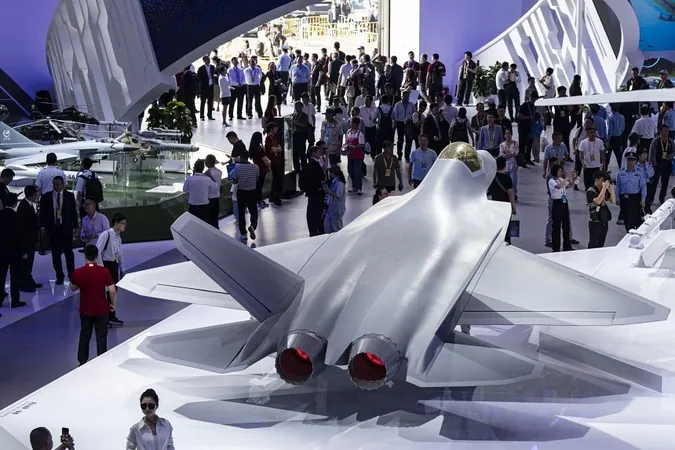
China’s J-35 Fighter Jet Makes a Splash at Zhuhai Airshow—Can It Break into the Global Market?
2024-11-15
Author: Daniel
BEIJING - Overview of the J-35's Debut and Significance
This week, the J-35, China's latest stealth fighter jet, took to the skies for its impressive public debut at the Zhuhai Airshow. With breathtaking aerial maneuvers that included steep climbs and dives, the J-35 left spectators in awe, solidifying its status as a central highlight of the event.
Comparison to the F-35 and Characteristics of the J-35
Seen as China’s answer to the United States' F-35 Joint Strike Fighter, the J-35 belongs to the fifth generation of fighter jets, characterized by cutting-edge stealth capabilities, superior maneuverability, and a sleek aerodynamic design. Its unveiling positions China as a formidable contender in military aviation, making it one of only two nations to operate multiple types of stealth fighters, alongside the U.S.
Development and Global Market Potential
The J-35 is the second stealth fighter developed under China's burgeoning military aviation program, preceded by the J-20 which began service in 2017. Although the J-20 is larger and not available for international sale due to its sophisticated technology, the J-35 is tailored for potential global markets, stirring interest among nations seeking to modernize their air forces.
Economic Motivations Behind the J-35's Development
Beyond military display, China's ambitions may have economic motivations. Over recent years, the nation has heavily invested in technology seeking to establish a foothold in defense exports. From satellite navigation systems to nuclear reactors, China's arms trade could soon expand to include advanced fighter jets, spearheaded by the J-35.
Potential Buyers and Regional Dynamics
Pakistan, a long-time ally, is positioned as a potential first international buyer for the J-35, with indications that its air force might look to replace legacy systems with this new entry. Regional dynamics suggest a strategic push for China to penetrate markets in the Middle East and Central Asia, targeting nations that might otherwise lean toward U.S. military cooperation.
Challenges and Classified Performance Data
However, despite the excitement surrounding the J-35, much of its performance data remains classified, restricting third-party assessments of its capabilities. Developed by the Shenyang Aircraft Corporation, the J-35's design hints at suitability for carrier operations, which would elevate China's tactical reach significantly in maritime zones.
Combat Effectiveness and Experience Comparison
Compared to the F-35, the J-35's specifications suggest a similar operational footprint, but its practical effectiveness in combat remains to be seen—the F-35 holds a significant advantage in combat experience, having been in operation for many years with countless flight hours logged.
Expert Opinions on J-35's Impact
Analysts caution against overestimating the J-35's impact just yet. Military aerospace expert Douglas Barrie notes that while the aircraft is intriguing, its true combat potential will only be clear once it is officially integrated into the People’s Liberation Army Air Force.
Opportunities for Countries Seeking Alternatives to U.S. Defense Markets
China’s J-35 might find a niche with countries navigating restrictions from U.S. defense markets. For example, Egypt has shown interest in acquiring Chinese military technology following a history of constraints on U.S. sales due to political pressures, highlighting the J-10C as part of its strategy to revamp its air forces.
Global Arms Export Statistics and Market Share
Unmet demand is palpable in regions where political relationships with the U.S. lack compatibility—such as the case with the United Arab Emirates and Azerbaijan, which have occasionally faced restrictions in American arms procurement processes due to geopolitical tensions.
Barriers to Becoming a Dominant Fighter Jet Supplier
Additionally, while China's reliance on arms exports has significantly increased, it still faces steep challenges in becoming a dominant fighter jet supplier. Between 2000 and 2020, China exported a mere $7.4 billion worth of military aircraft, in stark contrast to $62.8 billion from Russia and $99.6 billion from the U.S. for the same period.
Political and Security Concerns for Prospective Buyers
Political and security implications weigh heavily on any prospective buyers of the J-35. For nations seeking to establish military independence, concerns regarding maintenance, spare parts access, and support from China may hinder decisions. Strategic alignment is vital for any deal involving advanced military hardware, as geopolitical tensions can lead to supply chain disruptions.
Conclusion: Future Outlook for the J-35 in Global Defense Markets
In conclusion, while the J-35 soars in public perception, the route to becoming a competitive alternative in the global arms market remains fraught with strategic, economic, and political hurdles. As countries assess their military needs and alliances, the J-35 presents an intriguing opportunity that may redefine air power dynamics—if it can overcome the many challenges ahead. As China advances its military modernization, the outcome of potential sales could reshape the global defense landscape, marking a pivotal chapter in military history.




 Brasil (PT)
Brasil (PT)
 Canada (EN)
Canada (EN)
 Chile (ES)
Chile (ES)
 Česko (CS)
Česko (CS)
 대한민국 (KO)
대한민국 (KO)
 España (ES)
España (ES)
 France (FR)
France (FR)
 Hong Kong (EN)
Hong Kong (EN)
 Italia (IT)
Italia (IT)
 日本 (JA)
日本 (JA)
 Magyarország (HU)
Magyarország (HU)
 Norge (NO)
Norge (NO)
 Polska (PL)
Polska (PL)
 Schweiz (DE)
Schweiz (DE)
 Singapore (EN)
Singapore (EN)
 Sverige (SV)
Sverige (SV)
 Suomi (FI)
Suomi (FI)
 Türkiye (TR)
Türkiye (TR)
 الإمارات العربية المتحدة (AR)
الإمارات العربية المتحدة (AR)